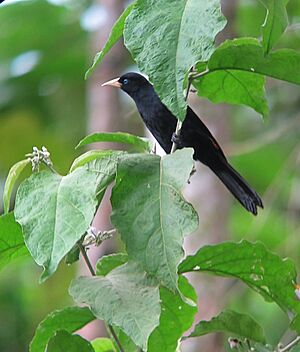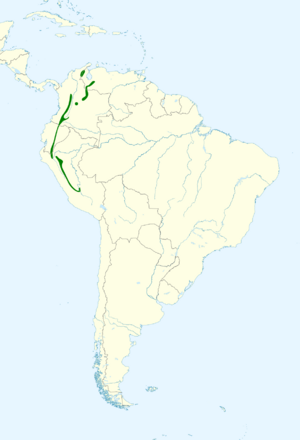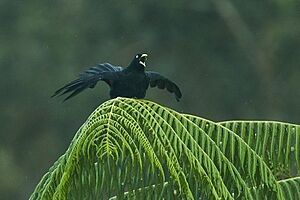Subtropical cacique facts for kids
Quick facts for kids Subtropical cacique |
|
|---|---|
 |
|
| in Colombia | |
| Conservation status | |
| Scientific classification | |
| Genus: |
Cacicus
|
| Species: |
uropygialis
|
 |
|
The subtropical cacique (Cacicus uropygialis) is a type of passerine bird, which means it's a songbird. It belongs to the New World family called Icteridae. These birds live and have their babies in the lower parts of the northern Andes mountains.
Contents
Meet the Subtropical Cacique
The subtropical cacique is a fascinating bird. It's known for its bright colors and interesting sounds. This bird is part of a group of birds called caciques. They are often found in forests in Central and South America.
What Does a Subtropical Cacique Look Like?
Subtropical caciques are sexually dimorphic. This means the male and female birds look a bit different, mostly in their size. Male caciques are about 25 cm (10 in) long. They are a bit bigger than their close relatives, the scarlet-rumped caciques.
This bird is slender with long wings and a short tail. It has striking blue eyes and a light yellow, pointed beak. Most of its feathers are black. But it has a bright scarlet (red) patch on its lower back and upper rump.
The female cacique is smaller than the male. Her black feathers are also a bit duller. Young caciques, called juveniles, have brownish feathers. Their rump patch is more of a brownish-orange color.
What Sounds Do They Make?
The songs of the subtropical cacique are quite unique. They don't sound like typical icterid birds. Instead, their calls are more like the excited chatter of a great thrush (Turdus fuscater). Imagine a bird that sounds like it's having a very lively conversation!
Where Do Subtropical Caciques Live?
Subtropical caciques live along the slopes of the Andes mountains. They can be found at heights from 1,000 to 2,300 meters (3,300 to 7,500 ft) above sea level. Sometimes, they are seen as high as 2,450 meters (8,040 ft).
Their home is usually in submontane or cloud forests. These forests have a lower tree cover, often with trees only 15 to 20 meters (49 to 66 ft) tall. You might find oak trees there. The forests also have many Epiphytes (plants that grow on other plants) and hemiepiphytes like Coussapoa. The ground layer is usually thick with tree ferns and other plants.
These birds live in several countries. Their range stretches from Venezuela, through Colombia and Ecuador, all the way to Peru. There is also a separate group of them in the Serranía del Perijá mountains.
What Do Subtropical Caciques Eat?
Subtropical caciques look for food high up in the trees. They often do this in small groups. Their diet includes large insects and spiders. They also eat small vertebrates (animals with backbones). Besides meat, they enjoy eating some fruits too.
These caciques often join mixed-species feeding flocks. This means they team up with other strong and noisy songbirds to find food. These groups might include other icterids, black-faced grosbeaks, or American jays. Such loud flocks can even attract other birds like trogons or flycatchers.
Subtropical Cacique Reproduction and Nests
Unlike some other caciques, these birds usually don't nest in large groups. They build a special bag-shaped nest. This nest is usually found hanging from the end of a tree branch. It is built about 3.5 to 30 meters (11 to 98 ft) above the ground. Often, the tree they choose also has an active wasp nest. This might help protect their own nest from predators.
The nest itself is 36 to 64 cm (14 to 25 in) long. It gets wider at the bottom. The female bird usually lays two white eggs that have dark spots. The male bird helps feed the young chicks once they hatch. However, only the female sits on the eggs to keep them warm.
Conservation Status
The subtropical cacique is not very common. In some places, it is quite rare. But because it lives across a very large area, it is not currently considered to be in serious danger.



